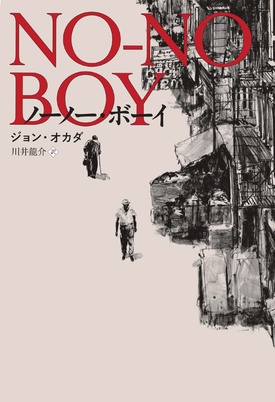A new Japanese version of "No-No Boy" will finally be published next month. The publisher is Shunposha (Bunkyo-ku, Tokyo), a company that publishes books on social issues and lifestyle themes, with a focus on labor and welfare. The English version has been a best-seller, with 18 printings to date, selling over 150,000 copies. A translation was also published in the past, but it has been unavailable in Japanese for the past 10 years, so it is now possible to deliver it to Japanese readers in a new look for the first time in a long time.
Jun Kawada, who designed the book's cover, said after reading the translated manuscript, "This is quite a work," and was moved by the story of the main character, Ichiro, and expanded his imagination. The cover illustration is by Akira Yokoyama. The delicate, charcoal-colored touch is very tasteful, reminiscent of the Jackson Street area in Seattle, where the novel is set.
The title is written in large English letters, "NO-NO BOY," with the Japanese "No-No Boy" written in smaller letters overlapping it. Of course, the Japanese title of this book is in Japanese, and in that sense it is unconventional. However, this allows the world of "Japanese American" to be expressed, and since "NO" and "BOY" are fortunately words that anyone from junior high school age onwards can understand, it allows the reader to easily expand their imagination.
When this book was first published by Charles E. Tuttle in 1957, it was just a story. When it was republished in 1976, a preface by poet Lawson Inada and an afterword by playwright Frank Chin, who were involved in the republishing, were added at the beginning and end, making it an unusual structure for a novel.
When the translation by Yo Nakayama was published in Japan by Shobunsha in 1979, the preface and afterword were also translated. A new edition was published in the United States two years ago, which added a preface by Japanese-American writer Ruth Ozeki, resulting in a new preface and afterword.
This explains the circumstances that led to the reprinting and the current evaluation of the book, but considering that it is a novel, the book feels heavy overall. In particular, the fact that there are two prefaces before the main text of the novel may be a challenge for first-time readers. Even classics and masterpieces that are reprinted do not usually have explanatory texts at the beginning.
In this new Japanese translation, I have made it possible for readers to read the novel, just like a normal novel, based on the idea that "if it's a novel, the novel should come first." Finally, I have added a lengthy explanatory afterword titled "John Okada and the Background of the Story," which includes a summary of the English preface in the volume.
In it, I, the translator, write about how I came to translate this book, starting with my chance encounter with the old Japanese version in a used bookstore in a small town about 20 years ago. I also explain the historical facts at the time when "No-No Boy" was created, and the situation Japanese Americans, especially second-generation Japanese, were placed in.
When I first encountered this book, all I knew about Japanese Americans was that they must have felt ashamed and suffered hardships during the Japan-US war. However, regardless of that, I found myself interested and re-reading it several times. I can honestly sympathize with the story and the suffering of the protagonist, Ichiro, and I am convinced that the novel itself has a strong power to attract even first-time readers.
By taking on the challenge of translating the book, I was able to notice the delicacy of the work and its charm that could not be seen through translation. I would like to touch on this in my next post, but just as I finished translating the book, Donald Trump coincidentally won the presidential election. And shortly after, I heard the shocking news that the transition team for the new administration was considering a registration system for Muslim immigrants as a counter-terrorism measure, citing the internment of Japanese Americans during World War II as a "precedent."
The Japanese American National Museum has also strongly protested against this, citing a policy that could be seen as a lesson in American democracy as an effective means. Now that it has been 75 years since Pearl Harbor, we would like Japanese readers to read Ichiro's story as a way of reviewing the lessons of history.
© 2016 Ryusuke Kawai







